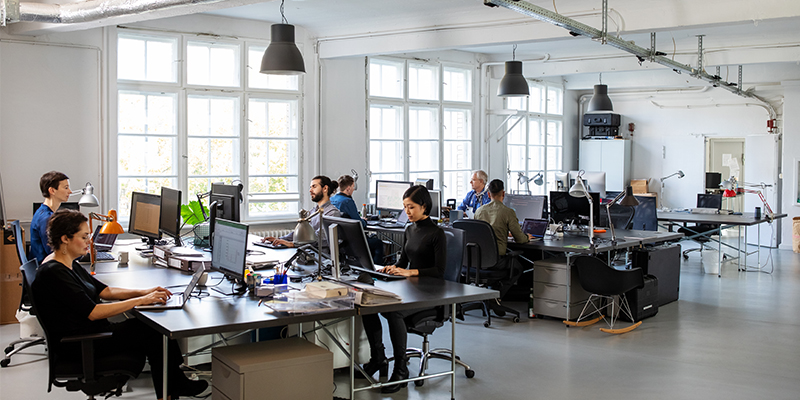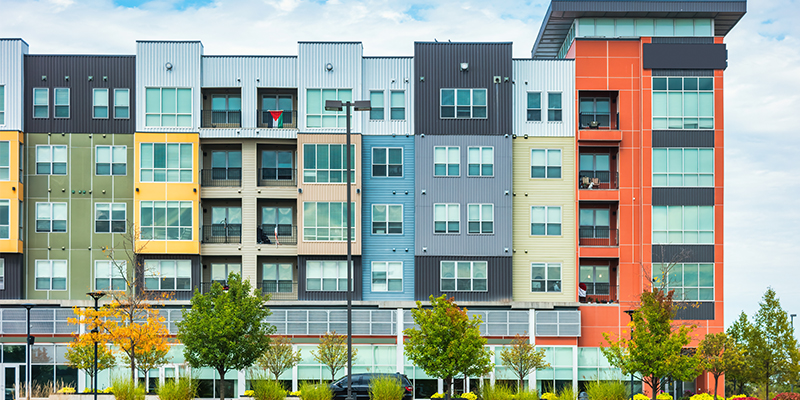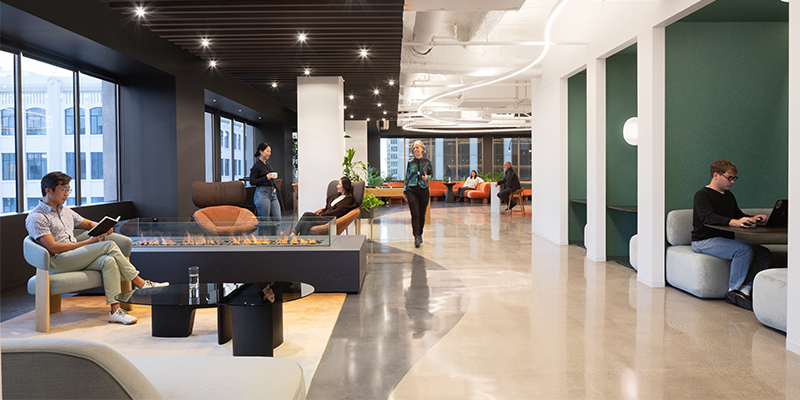Undoubtedly, office starts are below pre-COVID levels. But the cataclysmic drop that some had expected has not yet occurred: This year, construction began on 46.6 million square feet of new office space, with the expectation of equaling the 62 million square feet of new stock that was released to the market in 2021, according to the latest report from CommercialEdge.
However, new projects serve as an example of the sector’s continuous spatial and property class adjustments as it rebalances to post-pandemic conditions. For instance, while Sunbelt markets continue to experience only modest decreases or a veritable office boom, gateway markets – like San Francisco; Washington, D.C.; and Chicago – are adding new office space at a noticeably slower rate. At the same time, new and planned office starts in Austin, Texas; Charlotte, North Carolina; and Nashville, Tennessee, will increase local stocks by 15% to 23%.
Additionally, urban initiatives beyond the central core have replaced central business districts (CBDs) as the favored location for new starts. More precisely, the national stock will rise by 4.3% as a result of ongoing and upcoming office building in CBDs, while new starts in urban areas will add the equivalent of 13%.
Accordingly, with fewer leases being renewed, the vacancy rate for September (which was 16.6%) is projected to increase. Even so, as the flight to quality continues to deepen, new office projects are going up. And, at the conclusion of the first three quarters of the year, Class A and A+ office starts totaled 130 million square feet, while Class B accounted for fewer than 10 million square feet.
Notably, the office market is adjusting to tenants’ flight to quality, as well as the imbalance between decreased demand and surplus space supply. That said, nationwide vacancies are still rising and listing rates are down: The average full-service equivalent listing rate in the top 50 U.S. office markets was $37.67 in September – down 2.4% from the same month last year. Meanwhile, the national vacancy rate was 180 basis points higher in September 2022 than it was in September of last year, ending the month at 16.6%.
What’s Happening in Markets Across the U.S.
Furthermore, in many cities, average listing rates have decreased, and vacancies have increased during the past year – but not in Miami. The city currently has a 12.1% vacancy rate, while its average listing rate increased 12.4% over the previous year, driven by the movement of businesses and employees to Florida during the past two years.
Nationwide, 139.1 million square feet of brand-new office space is now being built. Of that, construction on 46.6 million square feet of new offices has already begun in 2022, putting the year on pace to equal 2021’s 62.2 million square feet.
Plus, office starts haven’t decreased as much as anticipated during the pandemic, even though the new supply pipeline won’t provide starts at pre-pandemic levels anytime soon. (These were typically north of 80 million square feet yearly.)
In Los Angeles, 3.6 million square feet of building started in 2019, although just 61,000 square feet of non-owner-occupied office space have started this year. In Chicago, 1 million square feet has been started so far in 2022 – down from 5 million three years prior. And, in Washington, D.C., new projects decreased from 4.7 million square feet in 2019 to 1.1 million this year. Similarly, in Manhattan, it declined from 3.2 million square feet in 2019 to just 754,000 in 2022.
With $4.1 billion in volume, the Washington, D.C. market was one of the busiest in 2022, nearly matching the $4.5 billion in sales registered in each of the two years prior. Specifically, 601 Massachusetts Ave. NW – a 478,818-square-foot building that sold for $531 million ($1,109 per foot) – is the most expensive asset in the market thus far, both in terms of overall cost and price per square foot. Boston Properties delivered the amenity-rich structure in the Seventh Street Corridor in 2015 and later sold it to Mori Trust.
With an asking rent of $66.75 per square foot in September, San Francisco continued to dominate Western cities in terms of rents. This is more than double the national average and was the result of a 3.3% year-over-year (Y-o-Y) rise. The Bay Area came in second with an average rent of $53.93 per square foot. That’s down from $55.46 per square foot a year earlier, although vacancies increased 0.11% during the same period.
What’s more, despite the fact that Los Angeles office rents have historically been higher than those in San Diego, rankings have recently changed. This is most likely a result of the San Diego office market’s increased resilience due to its robust life sciences industry. Consequently, Los Angeles recorded a rate of $43.06 per square foot at the end of September, compared to $43.91 in San Diego.
In the Pacific Northwest, Seattle continues to have higher asking rents than Portland, Ore., with prices coming in at $36.79 per square foot and $30.09 per square foot, respectively. And, although Seattle’s office rent increased from the previous year, Portland’s fell by 0.9%. Denver office rents also increased – albeit slowly – by 0.6% Y-o-Y to $30.14 per square foot.
In the Midwest, asking rents increased month-over-month in Chicago and the Twin Cities, but decreased year-over-year in both. Consequently, Minneapolis-St. Paul finished September at $25.64 per square foot – down 4.9% from the previous year. Likewise, rates in Chicago decreased at a slower 2.1% rate, from $28.09 per square foot in September of last year to $27.51 in September 2022. The Twin Cities also had a slight decline in vacancies, while Chicago’s office market recorded a 3.1% increase.
With asking rents rising and hitting $48.32 per square foot, Miami maintained its position as the office market leader in the South. It was followed by Austin, Texas, where the price per square foot dropped 4% Y-o-Y to $42.03 per square foot. Conversely, Washington, D.C. saw its rate rise by more than 2% Y-o-Y to $41.43 per square foot. Overall, the average asking rent decreased in half of the 10 Southern office markets that are in the top 25 in the nation and simultaneously increased in the other half.
Meanwhile, in Texas, Austin wasn’t the only location where prices fell below their mark from the previous year: Houston’s rates increased by 1.6% Y-o-Y to settle at $29.86 per square foot. Additionally, asking rates in the Dallas-Fort Worth region were $28.50 per square foot (0.9% less than in 2021), while vacancies increased by 0.6%.
And, in Florida, Orlando prices increased to $23.70 per square foot, but vacancies also increased 1.7% Y-o-Y. Tampa’s rates trended also lower at $28.09 per square foot, with 1.3% more vacancies than in the previous year.
Manhattan continued to have the highest asking rent in the country, finishing September at $70.37 per square foot – a 0.8% decrease from the previous year. Neighboring borough Brooklyn had the second-highest office rent in the Northeast at $50.24 per square foot. Otherwise, the three markets with the next-highest rentals were Boston, New Jersey, and Philadelphia, with rates of $40.33, $32.88 and $30.58 per square foot, respectively.
As anticipated, Manhattan closed $5.46 billion in office purchases, handily exceeding the next-largest city, Washington, D.C., which closed $4.1 billion in sales. Meanwhile, Boston’s total sales missed the $4-billion mark by just $2 million. That said, Boston’s sales volume also exceeded that of New Jersey ($2.21 billion), Philadelphia ($1.03 billion) and Brooklyn ($607 million) combined.
Finally, the year-to-date prices per square foot in Philadelphia and New Jersey ($200 and $234 per square foot, respectively) fell below the $263 national average. However, Manhattan, Boston and Brooklyn were among the five most expensive office markets in the country: Manhattan came in second with $858 per square foot, followed by Boston at $485 and Brooklyn at $480 per square foot.
For more details on the performance of the U.S. office market, as well industry and local insights, find the full report on CommercialEdge.








